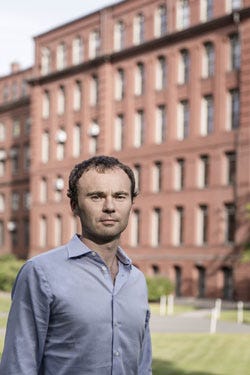A Harvard researcher—a 2016 Rolex Award Laureate—discusses his team's development of a soft, wearable exosuit for people with physical impairments.
November 15, 2016

Harvard researcher Conor Walsh--a 2016 Rolex Award Laureate--discusses his team's development of a soft, wearable exosuit for people with physical impairments.
Wearable robotic technology in the form of powered exoskeletons is undeniably one of the most futuristic and appealing developments in the medical device field today. The devices help patients impaired by spinal cord injuries or strokes walk. As miraculous as these capabilities are, the next phase of this technology is already on the way--soft exosuits that can be worn under regular clothing.
Conor Walsh, PhD, a core faculty member at the Wyss Institute for Biologically Inspired Engineering and the John. L. Loeb associate professor of engineering and applied sciences at the John A. Paulson Harvard School of Engineering and Applied Sciences, is one of ten 2016 laureate winners of the Rolex Awards for Enterprise. The 35-year-old Walsh, who is originally from Ireland, also heads the Harvard Biodesign Lab. He and his team of lab members and co-investigators are developing a soft robotic exosuit that not only offers walking assistance, but helps improve patients' natural movement over time, according to awards press material.
Learn about "How to Understand What Hospitals, Physicians, and Patients Want and Need from Connected Devices" at BIOMEDevice San Jose, December 7-8. |
Earlier this year, Harvard announced that the Wyss Institute for Biologically Inspired Engineering and exoskeleton company ReWalk Robotics would work together on the soft exosuit technologies. Walsh told Harvard's Office of Technology Development at the time, "ReWalk brings commercialization expertise and experience in the area of wearable robotics and complements our translation-focused research. Ultimately this agreement paves the way for this technology to make its way to patients."
According to Rolex Awards for Enterprise press material, the medical version could be available to patients in approximately three years.
Ahead of today's award announcement, MD+DI emailed Walsh a few questions--read on for a short overview of his work:
|
Walsh |
MD+DI: What is the background on the exosuits and how did you come to create this?
Walsh: We started working on developing the exosuit technology in 2012, initially with the goal of helping healthy people walk with less effort, and in 2014 began exploring the possibility of adapting the technology for patients poststroke. It was clear that there was an opportunity as poststroke gait is characterized by asymmetric and inefficient walking and we felt that the exosuit could help restore the function of the impaired limb to help these patients walk better.
MD+DI: What challenges have you faced with developing the exosuit?
Walsh: Developing wearable robots or exoskeletons requires a diverse set of expertise from robotics, to apparel design to human biomechanics and physical therapy. We have a great team with all of these disciplines and we collaborate together to develop designs that can work synergistic with the wearer.
MD+DI: What are the main findings of your studies?
Walsh: We have shown that a unilateral, soft wearable robot (exosuit) can supplement the paretic limb's residual ability to generate forward propulsion and ground clearance during walking and that one day may then help a person to train with a more normal walking behavior after stroke.
MD+DI: What should readers take away from your report?
Walsh: A key take away from our work is that delivering small levels of active assistance through a lightweight and non-restrictive interface can have a positive effect on the mobility of people with physical impairments.
MD+DI: Is there anything else you would like to add?
Walsh: I am a faculty member at Harvard and we undertake high risk research in my lab to generate new knowledge and technologies related to wearable robotics. Once we have demonstrated successful solutions to pressing problems it is also then important to be able to partner with industry so that these technologies can translate to society and have a positive impact on people's lives. For the exosuit project, we have partnered with ReWalk Robotics and are now working together to develop a plan to bring the technology to those who can benefit from it.
[Images courtesy of ROLEX / FRED MERZ]
About the Author(s)
You May Also Like



